Rachael Dickzen's Blog, page 17
July 31, 2019
How I Get My Cranky Anxiety-Ridden Old Man Cat to Take His Damn Prozac
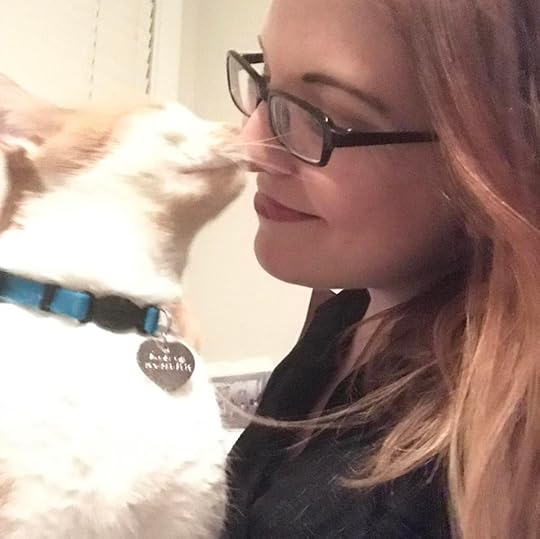
This is an older photo of us. My hair hasn’t looked like that in a while!
I’m starting to experiment with Amazon affiliate links, friends, so you’ll start to see links to products I personally use and love now. :)
Schrodinger Beethoven Dickson-Lorenzen is my first and most favorite kittyface. He purrs when he sees me, naps on my lap for hours while I’m working, and meows at me to turn on the bathroom faucet for him every night.
However, dude’s got some issues. He is pretty terrified of people and has a lot of anxiety. Now, some cats are shy naturally, but I don’t think that’s the case with Schrodes. He really loves people and loves being cuddled and pet, but he seems to be held back by his fears. He also still hisses at my husband John on a regular basis, although they’ve lived together for over two years now.
Based on my knowledge of his backstory before he was given up to PAWS (out in Chicago, they’re amazing) and his current emotional and physical health, here’s what I think probably happened. His previous owners got him declawed in his front legs. This resulted in his feet being really hurt by the cat litter, so he developed cat litter issues and ended up peeing basically everywhere else (the surrender papers were pretty awful to read). I’m guessing his previous owners got very frustrated by this and abused him in an effort to train him to stop doing it. He’s got one kidney that’s larger than the other, which probably means he was kicked at some point.
He stopped eating when he was at the main PAWS facility in Chicago, so they put him in a foster home with my bestie Holly. I met him through her and fell in love with him. For a long time, we had to put puppy pads in the litter box for him so he had a soft place to put his paws when he used the box. He hasn’t needed that in a couple years now, but it really helped him at the beginning when he was still recovering from the declawing and his previous owners’ abuse.
He was a pretty anxious cat who seemed lonely when I wasn’t around, so I adopted Ziggy Stardust pretty soon afterward so he’d have a friend. They’ve been great bros since and get along really well. He’s much happier now, but he’s definitely still got anxiety issues.So finally, last August, I went to the vet, explained the whole situation, and asked if we could get him on some anxiety meds. He’s been on daily Prozac ever since. He’s been on these meds for the past year now, but it took a LONG time to get him to take the meds regularly and consistently.
My Initial Attempts:First, I just gave him the pills in his food. He quickly caught on within a week or so and refused to touch them.
Second, I put the pills in pill pockets, which i then hid in his food. I got a few weeks out of that before he refused to touch it anymore. :/ (I later discovered that he greatly prefers the tuna and cheese pill pockets to the salmon ones! Picky animal.).
Third, I got fancy tuna-flavored liquid meds for him and tried putting it in his food, then just squirting it into his mouth. Each time, he caught on and struggled and fought against it even more.
[image error]
Empty Gelatin Capsules 0 Size -1000 Empty Capsules
I resorted to getting some flavorless gelatin capsules online to put his pills in (I bought a pack of 1,000 capsules on Amazon, which should last me a couple of years!). I do have to cut these down to a more cat friendly size, but it doesn’t take too long if i just do a whole bunch of them at once. I had to experiment with the best ways to use these capsules - for a while I actually was putting the capsules into a pill pocket and THEN covering it with tuna to get him to eat it, but I FINALLY FINALLY found a method that works. I’ve been getting him to take his medicine consistently in this way since April! HALLELUJAH.
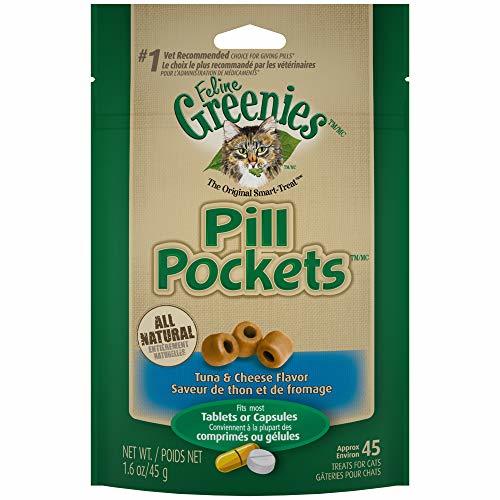
Greenies Feline Pill Pockets Natural Cat Treats Tuna & Cheese Flavor, 1.6 oz. Pouch (45 Treats)
It only took me NINE MONTHS to figure out a system that consistently works!
So. What I do.
My Foolproof Method of Getting Schrodinger to take his damn pills:Cut a flavorless gelatin capsule down to a cat friendly size. Put his pill into the capsule.Put the capsule into a tuna and cheese pill pocket, Schrody’s favorite. [I actually work in batches and put a ton of pill/capsule/pill pockets together at a time. I store them all together in a bag so the pill pockets don’t dry out. The capsules soften up a little within the pill pocket, but Schrody doesn’t seem to notice or care.]Once Schrodinger starts eating his morning wet food, I put the pill pocket into the food immediately next to where he’s scarfing, so he eats it up without even really noticing it. It works every time!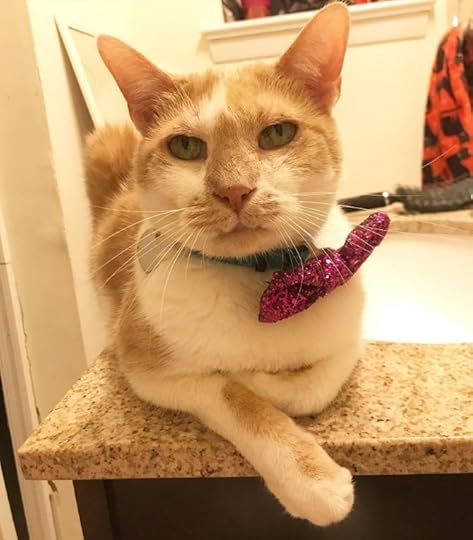
Just look how pleased he looks with himself.
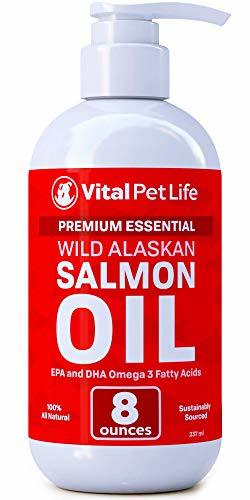
Salmon Oil for Dogs, Cats, and Horses, Fish Oil Omega 3 Food Supplement for Pets, Wild Alaskan 100% All Natural, Helps Dry Skin, Allergies, and Joints, Promotes Healthy Coat, Helps Inflammation, 8 oz
I’ve also started squirting a little salmon oil on the pill pocket lately, as he’s been walking stiffly lately and I’ve read that it can help relieve joint pain in senior cats (he hasn’t been taking it long enough for me to really tell if it’s working, but he does lap up EVERY BIT OF IT, so clearly it tastes good).
The pills combined with more exposure to friendly people on a regular basis (because of the theater troupe that’s been rehearsing in our basement all summer) have REALLY helped him. He’ll actually come out to greet my friends now! He seems much more relaxed and happier.
He still hates my husband John, but that seems to be pretty mutual. Not sure there’s anything I can do about that at this point! But
July 30, 2019
Chronic Pain and Identity: I Do Not Talk About Spoons
A person with chronic illness, they say, has only so many spoons to get through a day. Each action, each sentence, each movement can take a spoon away, and when the spoons are gone, so is the energy, the ability, the strength left to face that day.
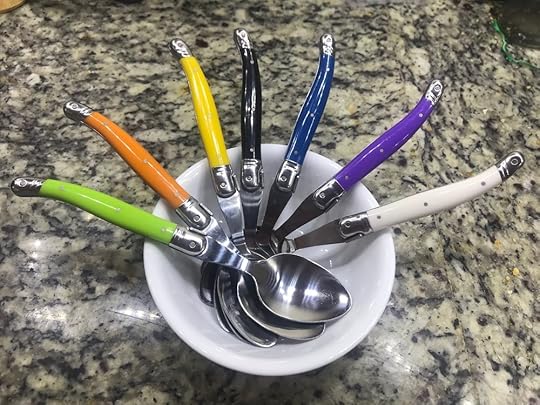
I have grown more comfortable talking about my pain over the years. I talk about it commonly now, I give it breath, it is a matter of fact topic in my week. Yet I do not talk about spoons. Spoons make me feel like an impostor, like I’m claiming a story that is not mine.
My pain sits heavy and aching in my neck, my shoulders, my jaw, where it has lived for years and years. It was small at first, and easy to ignore, and then it grew and grew.
Now it has made a home throughout my nerves and muscles. It has had so long to expand in my body that it has remodeled, painted the Pepto-Bismol pink bathroom blue, planted perennial flowers, hung pictures on every wall. Its domesticity has been so insidious that I do not know when it moved in, or why, or how. I know it now better than my friends, better than my husband, for it is with me all the time, in every moment, in every joy and sorrow and scrap of boredom. My pain resides within me contentedly without fear; it knows its tenancy is permanent. It sleeps with me every night; it rises with me every morning.
I am a woman and society has taught me not to complain, so years and years built on before I started voicing the concern that this was not quite right. I spoke at first timidly, than louder and louder until I was singing a song of my pain, writing an opera about the ways I felt broken, pouring out my melody. I crescendo to a fortississimo, like Holst and his planets chanting about war, like Turandot singing for her freedom. I sing as I must to have someone notice me. Help me, I beg, something is wrong; good thoughts and music are not enough to make it stop.
I went through a phase in my 20s where I was convinced something was so not right with me that I’d joke darkly about not surviving until I was 30. I had no evidence to support this, none at all, but I was so young and so full of life - the pain residing in my bones persuaded me that it was death.
A journalist recently asked to interview me about my experience with chronic pain. Beforehand I tried to jot down a few notes, trying to recall all the doctors I’ve seen, the treatments I’ve tried, the thoughts I’ve had. My “notes” turned into three pages, over 1,000 words of my misery. I spoke to that journalist for 40 minutes. I haven’t heard anything about it since; I half wonder if I have perhaps scared her off.
But with all that, I am indescribably lucky. My pain is constant but low level. I may need to use a book holder to avoid agonizing my neck when I need, I may own every gadget and cream touted by Buzzfeed that’s supposed to reduce muscle tension and soothe my burning nerves, but I can live my life generally without any great trouble. I do not have many issues with fatigue or energy; I can’t move my neck as far in any direction as I’m supposed to be able to, but there are no activities I explicitly cannot do. The adult gymnastics class I went to recently left me sore and hurting for days after, but I did it.
And thus because I am functioning decently, I do not talk about spoons. I do not usually refer to myself as disabled; I do not feel I have a right. There are so many who struggle more than I do. I often fear that by admitting I too struggle, in various ways, I may steal a status which is not mine, appropriate a life not my own, acquire the pity of others.
I do not want it, you know.
It makes no sense. I too, get tired sometimes. If pain is my longtime tenant, depression and attention deficit disorder are my neighbors - not always visibly present, but usually close by with a wave or an awkward conversation to remind me they’re there. On some days, all three will gang up on me and I find I cannot move forward or back, but stand paralyzed by my own body’s confusion and misery. I too, can run out of spoons.
Yet I fear to say these things, I fear to put them in these words.
I do not speak of spoons.
July 29, 2019
"Purr Like an Egyptian": Inspiration from Daphne Du Maurier and Ancient Egypt
Have I mentioned that my cats-taking-over-Memphis story "Purr Like an Egyptian" will be in Grumpy Old Gods Volume 2? It's open for Pre-orders now and will publish on August 9! https://www.amazon.com/gp/product/B07VJZVM5C
This was the first short story I’d written since…high school? Junior high? I just heard about the submission prompt and I was instantly captivated; I HAD to write a story for it.
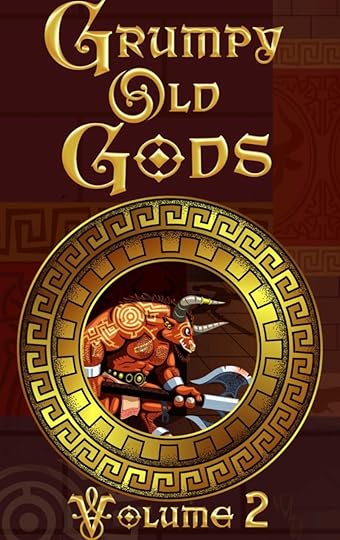
We’re looking for stories about mythical Gods who are waning, reborn, retired, or otherwise AWOL from their assigned post.
We invite you to re-imagine old myths, mine your local retirement home for things that tickle your fancy, and invite your Muse to go wild. The only requirement is that the god or goddess in question (or whole pantheon if you so choose) must be retired, retiring, waning in power, or ignoring their responsibilities. Bonus points for good humor.
I mean, how amazing is that? I came up with the idea to use Bastet, the Egyptian Goddess of cats, pretty easily, and I knew I wanted her to run a cat cafe. The idea of all the cats migrating to Memphis to be near her developed more slowly over time.
Once I did get that idea though, I knew I wanted to look to Daphne DuMaurier’s The Birds, which has a similar premise, only much more frightening. I tried to get across a similar, but more modern, depiction of animals taking over a town. In addition, my intro was a direct homage to the story’s beginning.
The Birds:
On December the third, the wind changed overnight, and it was winter. Until then the autumn had been mellow, soft. The leaves had lingered on the trees, golden-red, and the hedgerows were still green. The earth was rich where the plow had turned it.
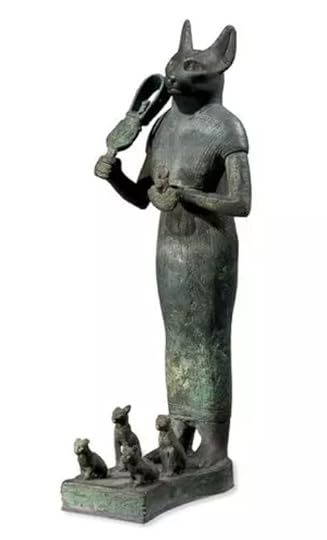
Purr Like an Egyptian:
On March 10th, Tennessee finally realized it was spring and the temperature rose 20 degrees. Everywhere in town smelled damp, like fresh sod, green and expectant.
So my opening is a bit more folksy to bring across the humor of the piece, but you get the idea.
I also specifically picked out names for everyone in the story that had an extra layer of meaning for anyone who bothered to look into it. In the story, Bastet’s human form goes by Nenet Elmasry. Nenet means “divine, spiritual,” and “Elmasry” literally means “The Egyptian.” Her husband, Sef, is the human form of Ptah, the god of craftsmen. His physical description matches Ptah’s - hairless and wearing a skull cap. “Sef” literally means “yesterday.”
I also used to have a cat character named Aten who was intended to represent the divine cat aspect of Ra, who was strongly associated with Bastet, but I ended up cutting him out during the editing process. We just didn’t need another cat around, particularly one with more of an obscure origin. Aten means “sun,” which referenced Ra as the sun god.
July 27, 2019
On Being Ill, with Rachael and Virginia
While on the subject of chronic pain, it appears I might have an even newer, funner type. :/
As I’ve mentioned before, I’ve been feeling pretty terrible for the past ~5 weeks at this point. I’ve been having a ton of painful sinus pressure, headaches, and fatigue, along with fun spats of dizziness, lightheadness, blurry vision, and nausea. I’ve seen my general practitioner twice in the past month; he said my sinuses were inflamed, so we assumed it was a sinus infection. I’ve tried three different antibiotics and a course of oral steroids.

This photo meme of my cat wearing a tie has nothing to do with this post but look how charming he is!
I still feel awful, so I went to an ENT (ear, nose, and throat) doctor yesterday. Dr. Sharma looked around in my nose with a scope and told me that there’s actually no sign of a sinus infection at all, or any sign of what is actually causing the pain. He posited that it might be a side effect from one of my medicines, so he started looking around online for those, but didn’t find anything that seemed to fit. His next suggestion was to wait a few weeks before I get a head CT, but it’s been so long and this is really affecting me so badly at this point, that I just asked if we could do the CT now. I’ve got an appointment next Wednesday.
This constant pain in my maxillary sinuses and head is really starting to take a toll. I’ve had way more trouble this month focusing on work than I usually do. I’ve taken off more sick days than I have in years (although of course not as much as I’d like, because I can’t actually afford to take off that many days), and I haven’t been writing as much on my short stories or on this blog as I’d like. And now on top of that, I’m worried about what it might be that’s causing all this. It might be like, sinus headaches or something simple I can treat relatively easily and quickly. Or it might be something more serious (my mother helpfully informed me shortly after I relayed this information to her that two members of my family have died from brain aneurysms in the past. So comforting, right?).
I’m rather nervous about it all, and my nerves are already frayed from ~35 days of sinus pain and headaches, but I’m trying not to google symptoms any more and just be patient. I may need to meditate and read a lot more over the next couple days to keep my mind off of it. Because even if the CT doesn’t give me a definitive diagnosis, it will at least be helpful for ruling out options.
It all makes me think of Virginia Woolf. In 1925, when she was in bed recovering from suffering a nervous breakdown, she wrote “On Being Ill,” a beautiful essay on the nature of illness that was published by T.S. Eliot in The Criterion. In it, she asks, how can something so common and universal be so little written about?
Her opening sentence can be a little hard to read, as it just keeps going and going, but it is so beautiful when you actually parse it out and examine it [line breaks mine]:
Considering how common illness is, how tremendous the spiritual change that it brings,
how astonishing, when the lights of health go down, the undiscovered countries that are then disclosed, what wastes and deserts of the soul a slight attack of influenza brings to light, what precipices and lawns sprinkled with bright flowers a little rise of temperature reveals, what ancient and obdurate oaks are uprooted in us in the act of sickness,
how we go down into the pit of death and feel the waters of annihilation close above our heads and wake thinking to find ourselves in the presence of the angels and the harpers
when we have a tooth out and come to the surface in the dentist’s arm chair and confuse his ‘Rinse the mouth—rinse the mouth’ with the greeting of the Deity stooping from the floor of Heaven to welcome us
—when we think of this an infinitely more, as we are so frequently forced to think of it, it becomes strange indeed that illness has not taken its place with love, battle, and jealousy among the prime themes of literature.
Then she continues:
Novels, one would have thought, would have been devoted to influenza; epic poems to typhoid; odes to pneumonia; lyrics to toothache.
But no; with a few exceptions De Quincey attempted something of the sort in The Opium Eater; there must be a volume or two about disease scattered through the pages of Proust—l iterature does its best to maintain that its concern is with the mind ; that the body is a sheet of plain glass through which the soul looks straight and clear, and, save for one or two passions such as desire and greed, is null, and negligible and non-existent.
And so she continues. You should go read the whole thing, it’s great.
I would like to write such wonderful odes to sickness. I think I will at some point. I feel I am getting better at writing all the time; already, just looking at stories from a few months ago, I see the things I would change or phrase differently now. I see how I would tighten a chapter or make a story beginning more interesting. I will write such things soon, but for now, I am behind on a short story I wanted to have finished, polished, and published online by now, so I should go work on that. But yet my head aches so, even with loads of ibuprofen and sudafed, and it is difficult for me to remember from moment to moment what I should be doing.
The “On Being Ill” essay was actually the first one to really get me to understand “creative nonfiction” as a concept. I learned about it from “Reading Like a Writer,” by Francine Prose, which helped me really start to think about the craft of my writing. That section actually helped “Estate Sale,” which was my first real attempt at creative nonfiction. I tried to emulate a lot of the imagery filed sentences and careless grammar that Woolf uses. This book also fed into my short story “The Caterer,” as it was what inspired the first and second person POV.
I don’t exactly know where I’m going with this post. I’m essentially saying I plan to write something epic and beautiful about illness someday, but not right now. This is but a Tribute .
July 24, 2019
An ADHDer's Guide to Chronic Pain: Daily Management Part 2
If you haven’t read the other parts of this series yet, here they are!
An ADHDer’s Guide to Chronic Pain: Getting a Diagnosis
An ADHDer’s Guide to Chronic Pain: Daily Management Part 1
4. Make Simple Adaptations in Your Daily Life to Reduce Your Pain
If you’re still having pain issues after getting treatment from a doctor and/or a physical therapist, look at what else is going on in your life that might be exacerbating it. Even if one thing isn’t /causing/ the pain, doesn’t mean it isn’t a factor in it. There are often a lot of small changes you can make to your life to reduce your pain level.
For example, sitting on a couch can actually really make my neck pain worse. It promotes bad posture and doesn’t give me the support I need. So I pretty much never sit on couches these days. I use a floor chair, which offers me a lot more support and still allows me to “chill out” in a way that a straightback chair doesn’t. Heavy purses also can make my pain worse, so I usually use a backpack if I’m carrying anything significant around. If I do use a purse, I make sure to regularly clean out anything that could make it heavier.
If you have neck or shoulder problems, like me, make sure you’re using a mattress and a pillow that properly supports your neck and body. You spend so much time sleeping that you NEED to have a good setup or you’re going to just undo all your pain relief work every night in bed. People have different opinions on pillows; I have, gosh, probably 3 that I’ve bought specifically for my neck? One that has water in it, another that’s got microfoam beads in it, and another one that’s memory foam. I’ve tried them all and the memory foam one works best for me personally, but you should try them out and take notes on how you feel the next morning to figure out what works best for you!
Finally, I’ve done a lot of research on home office ergonomics and made sure that my workspace actually fits right for my body. I recently discovered that my desk and chair heights were completely wrong for me! I’m so short that the average measurements for a man just aren’t accurate, so I had to modify a few things and add in a foot rest to make it all work. I also use a headset while making or receiving phone calls so I don’t have to crane my neck in weird ways to hold a phone.
5. Massages and Home Tools for Muscle Pain
Massages have never cured me of my pain, but they do tend to really loosen up my muscles and prevent them from “fossilizing” or getting overly stiff. I have a Massage Envy membership and go in once a month as a maintenance measure.
I wish I could afford to go in more often, but since I can’t, I also have numerous tools at home that I use for massaging or relaxing my painful neck/shoulder muscles. I leave little reminders for myself to use these tools in a mass to-do list note I keep on my phone and in my journal. Alarms can be good for this too, but if you’re setting an alarm for medicine and stretches and pain relief tools, you might just get to the point where you have so many that it doesn’t even register for you, so be careful with that.
One of my favorite tools currently is an acupressure mat and pillow, which has tiny plastic spikes all over it. I don’t entirely know how it all works, but lying on this really relaxes my neck and shoulders and make them feel like they’re “melting” and less stiff. It’s a relatively cheap option, but you do need to lie on it for 30 minutes + for it to have any effect. In addition, for best results, you probably want to be shirtless. So it’s not the most convenient pain treatment.
Another cheap and easy options are tennis balls and pressure point tools. I keep a Back Buddy Jr. by my desk and pull it out to work on my neck when it’s getting really stiff. It’s great for pushing on stiff areas you can’t quite reach on your own. Lying on a tennis ball or putting it in between your pressure point and a wall can be really effective, if initially painful. With these tools, you can either just apply pressure straight on, or you can rub the tool or ball around and on the stiff point; both techniques work pretty well.
I also have a massage machine that works really well when placed between my neck and a wall, but its fabric cover has come off over time, so it’s more painful to use than it used to be. I can’t use it too often without really irritating my skin.
6. Use Over-The-Counter Medication and Treatments
If you have chronic pain, you’re probably very familiar with ibuprofen, acetaminophen, and aspirin. These can be really valuable tools in reducing your pain, but remember to watch your dosages and not overdo it; you can definitely screw up your stomach or other parts of your body. Also remember, no aspirin if you’re under 18!
Here’s another trick though: taking a pain reliever with a small amount of caffeine can actually reduce your pain further. It’s unclear how much caffeine can do on its own, but it does appear that it can reduce joint pain and headaches as well. This article on Disabled World explores that topic if you’d like to know more.
There are a few natural supplements out there that can really take the edge off pain as well. I’ve tried turmeric and capsaicin pills before and had some good results. I also take vitamins, fish oil, and probiotics, which all play different roles in keeping my body healthy and reducing inflammation. WebMD has a great overview article of different supplements and how they treat pain.
Finally, don’t forget topical treatments! Lotions or rubs containing menthol or camphor create a cooling sensation that can really distract you and make you forget the pain. Capsaicin lotions can also really help joint pain or nerve pain, although it can also irritate your skin if you’re not careful. In addition, you’ll want to use gloves to apply this, as it can be pretty difficult to wash totally off your hands. I’ve accidentally got capsaicin in my eye before and it really hurts!
Well, that’s all I’ve got for now. Thank you for reading. I hope this helps!
July 23, 2019
An ADHDer's Guide to Chronic Pain: Daily Management Part 1
If you haven’t read the other parts of this series yet, here they are!
An ADHDer’s Guide to Chronic Pain: Getting a Diagnosis
An ADHDer’s Guide to Chronic Pain: Daily Management Part 2 (this post won’t be live until midday 07/24/2019)
I wrote this whole post and then realized it was over 2,000 words and should probably be split into two parts. Oops! Here’s the first one!
I’m a young adult with both ADHD and chronic pain. These two issues can often work counter to each other and cause a lot of frustration, but over the years, I’ve learned a few tips and tricks to get better about dealing with both of them. This blog post series will hopefully help other people dealing with the same issues- the first post addressed getting a diagnosis, and the second and third posts will address day to day management.
July 20, 2019
Don’t Lose Your Novel!: Responsible Computer Maintenance and Backups for Writers
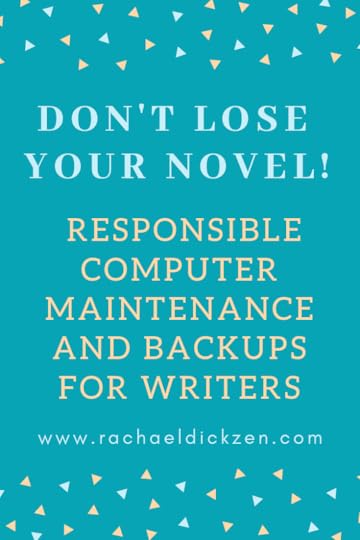
So I have a tiny little Lenovo Yoga I use for all my writing. It’s kind of beaten-up, as I’m fairly clumsy and good at dropping things. It actually has tape covering some broken glass in the corner (I added a protective hard cover after I did that, lol). And my husband says it’s a computer for ants. But it works beautifully for my needs. It’s small and light so I can carry it around anywhere easily; this is particularly important because of my chronic neck pain issues.
I’m not great at remembering to maintain my laptop or backup my files (with ADHD, remembering any regular but not daily activities can be pretty hard for me!), but as a writer, I’ve REALLY got to get better about that. I keep my works in progress on my computer and it would be devastating if I lost all my work due to a computer crash. It also can be really frustrating when my computer is lagging during my precious writing time. So I took some time this morning to fix it up a bit.
Cleaning Up the Computer
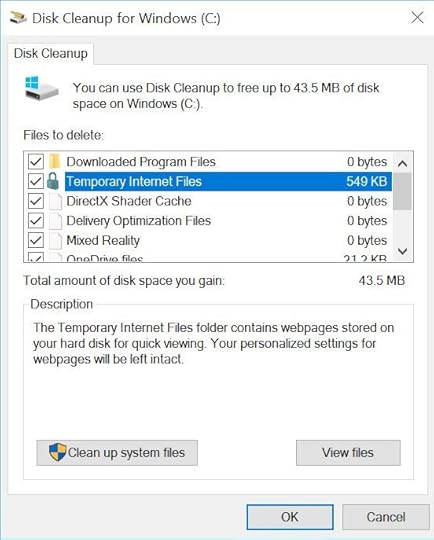
Since I have a Windows computer, I first launched Disk Cleanup and ran it to get rid of a lot of unnecessary files. This app offers numerous suggestions for what extraneous files to delete. This includes temporary files, things in the recycle bin, etc. I managed to get rid of several gigabites of excess files on my computer this morning! (I took this snip after I’d already run it). This should help my computer run quicker and more smoothly.
There are a LOT of computer cleaning apps and software out there, but my Google research indicates that they just aren’t necessary. As How To Geek says:
PC cleaning apps are digital snake oil. The web is full of ads for applications that want to “clean your PC” and “make it feel like new.” Don’t pull out your credit card — these apps are terrible and you don’t need them.
If you do want to “clean your PC,” you can do it for free. Windows includes built-in PC cleaning tools that can do almost all of what the average PC cleaning app will do for you.
That full article explains a lot about what Disk Cleanup actually does and why it’s just as good as add on softwares. It’s a good read if you’re interested in learning more.
I also went through and manually deleted several Chrome extensions I don’t use. While I was at it, I also reorganized the extensions I DO use to make sure they’re most visible, like my Pinterest button (which I use to post links to this blog) and the Honey button (which shows me when there are coupons to go with whatever website I’m on). There are some fun extensions I use that just don’t need to be visible all the time, like the one that turns all pictures of Trump into pictures of kittens (Make America Kittens Again). That’s great, but it works whether or not it’s showing up in the corner of my browser.
I also fixed up my bookmarks and organized them. This isn’t necessary for the computer to run well, but it makes the browser a lot nicer looking and also makes it much easier for me to find resources!
I have a tendency to have a ton of Chrome tabs open all the time, but that really does waste memory and results in some major lagging. As How to Geek says in yet another super useful article:
In Chrome, each tab opens in its own process on your PC. This is a good thing, because it keeps those tabs isolated from one another. A crash in one tab is not likely to bring down your whole browser. But, of course, each open tab uses up some resources, and when you have a lot of tabs open at once, it can slow things down.
The easiest way to fix this is just to close Chrome regularly and don’t keep 30 tabs open on your computer at once. That article also offers a few extensions that can fix this problem without closing the browser.
Backing Up the Computer
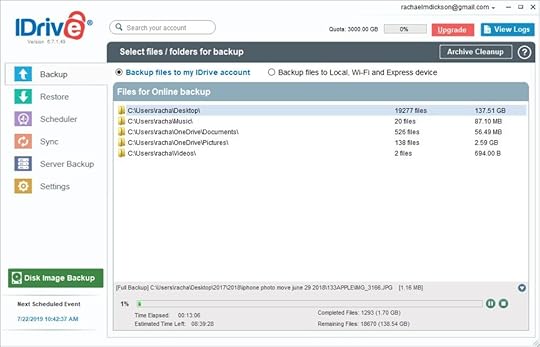
This is a simple but really important step! I’ve had a computer crash twice before without a backup and it really sucked. The first time was in 2009, and the computer had ALL my photos on it from my study abroad trip to Europe, so I ended up paying a recovery company way too much money to get my files off the hard drive. The second time was a few years ago when I got some ransomware via email. That time I just restored my computer completely and lost my files; I really didn’t want to pay someone $1,000 to get my own data back. Be wary of opening links in emails, friends, even if they come from your dad!
IDrive is running a deal currently where you pay $6.95 for a year of backups. I can set it up to automatically back up both my laptop and my phone as often as I like. I’ve personally got it running twice a week, but if you are really paranoid about your computer crashing, daily might be a better idea.
July 18, 2019
Story Ideas from History and Dreams
So I keep a note on my phone called “story ideas” that I just fill with different ideas as they strike me. Sometimes these are from dreams, often they are from books or history podcasts, some are just thoughts that come to mind that I have to get down on a page /right then/ or I’ll forget them!
Numerous of these scribbled ideas have turned into future stories. I had the idea for Most Horrible probably…a year and a half before i actually started turning it into a one act play? The entire concept of “Big Dave’s Goliath” came from a simple fact I had scribbled down- that various popes had ordered the removal of all the penises from the nude statues in the Vatican museum. When I came across the call for submissions for “Big,” which asked for stories around something or someone gargantuan, the idea of a giant replica of Michelangelo’s David, and the shenanigans that ensue when someone vandalizes the statue by cutting off its genitalia, came into being. True, it’s totally absurd (and that story was HIGHLY influenced by the over the top style of Carl Hiaasen), but it was really fun to write! And now it’s published in Colp: Big. :)
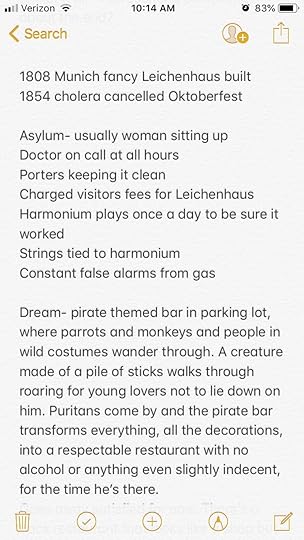
Here you can see notes on one of my history story ideas and one of my dreams!
The Caterer and the Vanguard (current work in progress) both were inspired by historical legends chronicled in “100 Cats Who Changed Civilization,” by Sam Stall. John gave it to me last December just as a fun gift; he had no idea what it would lead to! Hah. I have numerous other ideas for the AntiquiCats series originating from that book and other cat history sources online.
Here’re two snippets of my current “story ideas” note, featuring a few of my favorite ideas.
So Leichenhauses were WAITING MORTUARIES for people who were scared of being buried alive (circa 1800s). After death, the bodies would be set out and have like, strings tied between their bodies and either a bell or a harmonium or whatever. Then someone would sit up with the bodies and listen for movement noises. Bodies actually move a lot while they’re decomposing, so it must have been quite frightening! They were also viewed as a common tourist destination? It sounds utterly fascinating. I REALLY want to write a story set in one at some point and just haven’t found the right plot yet. I first heard about these from the brilliant Stuff you Missed in History Class podcast called “Not Dead Yet - Safety Coffins and Waiting Mortuaries.”
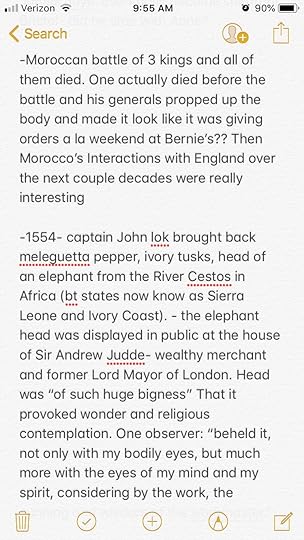
I’ve also gleaned several ideas from a book I’m currently reading - Black Tudors, by Miranda Kauffman. It’s very good but very dense and academic, so I’ve been reading it off and on for MONTHS. I’ll finish it some day.
July 17, 2019
How I Got Back Into Writing Seriously
The Lifelong Dream
Honestly, I cannot remember a time when I have not wanted to write and be an author. Some of my earliest dreams and goals as a child involved writing as a career. My family LOVES books; literally every room in my parents’ house except the bathrooms have bookshelves and books in them. It was a wonderful place for a child to grow up. I eagerly read as many books as I could; they fascinated me and brought me to a whole other world. I wanted to make those worlds myself.
And in elementary school I did. I was always writing stories or poetry or songs or whatever. My output turned into mostly just poetry over time, as I discovered journalism and imposter syndrome. For a long time, I felt that nonfiction journalistic writing was the only thing I could do. Fiction seemed too hard. I tried doing National Novel Writing Month several times and never managed to finish; this made me feel like a failure. I had lots and lots of ideas written down in various places, but none of them ever came to fruition. I’d start and stop and get distracted and frustrated. For a while I had resigned myself to not really being a writer. I did do some writing and research on marital surnames, and had an inkling to turn it into a nonfiction book, but I wasn’t following through on any of it.
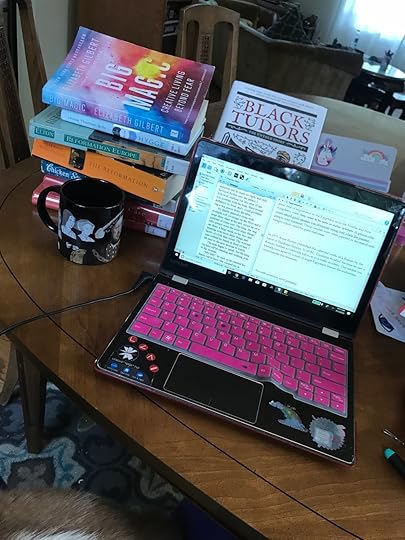
I usually write at the kitchen table these days, surrounded by books and journals.
The Turning Point
So fast forward to my 30th year of life, when I finally got on a combination of treatments that actually treated my depression successfully. This really changed my life in so many ways. I had a focus and a determination that I hadn’t had previously; my depression was no longer a barrier dropping in front of me, but a curtain pulled to the side. I could see it and respect it and treat it carefully, but I could walk through it without a problem.
When my beloved Shakespeare troupe Britches and Hose announced that they were holding a New Works Festival and needed submissions of original one acts, I decided that it was time to take one of my favorite ideas and turn it into a play. That’s how “Most Horrible,” a one-act prequel to Hamlet set in Purgatory began. I was so excited and motivated by this success that I continued on - and turned the play into a project for National Novel Writing Month in November. I finished up the novel by the end of January (I have, of course, decided to add in a whole new historical context and many more subplots, so I have major edits and revising coming up, but that’s another issue).
Since NaNoWriMo had worked so well for non-depressed Me, I decided to set monthly goals for myself. January’s was finishing the novel, February’s was working on my nonfiction book proposal. I didn’t really have any plans to write short stories until I came across a fascinating writing prompt on the Internet - calling for short stories about Grumpy Old Gods, gods that in some way were shirking their duty. I was so excited about this concept that I outlined and wrote “Purr Like an Egyptian” fairly quickly, in only a week or two! And it felt so good to have a project wrapped up and submitted so quickly, that I decided I’d dedicate March to writing more short stories and poetry to submit to various magazines and publications. That’s how I also wrote “Big Dave’s Goliath” and “The Caterer.”
Currently
So here we are now. “Purr Like an Egyptian” was just accepted for publication in Grumpy Old Gods Vol. 2 and will be coming out later this month. “Big Dave’s Goliath” was published recently in Gypsum Sound Tales’ Colp: Big. I’ve also had a few literary nonfiction pieces published as well - on Talking Soup and The Drabble.
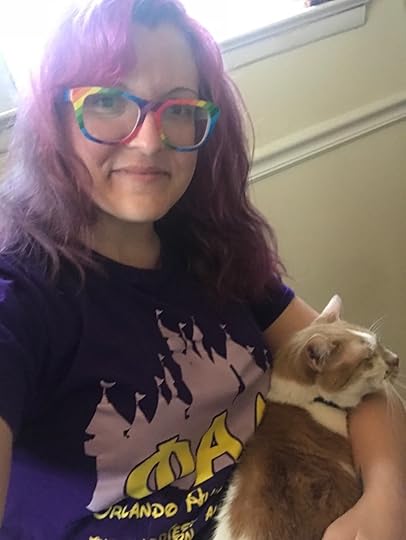
I also tend to write with my own personal demigod in my lap. (I’m writing a lot about ancient Egyptians lately- cats WERE their demigods)
“The Caterer” was rejected, but I invested a lot of time into revamping and revising it to make it better, and then published it myself on Kindle Direct Publishing as an experiment. I’ve enjoyed the writing and promoting process for my own ebook so much that I am now writing another story in the series, with plans for more! Once I finish and publish my second volume (“The Vanguard”), I plan to get back to “Most Horrible” and revise it to add in the Danish reformation (no biggie, right?).
It’s a lot of work, as of course I have a full time job as a trademark examining attorney at the USPTO, participate in Shakespeare plays with my friends, and occasionally like to have some downtime to spend with my husband, but it’s been so worth it. I don’t know if I’ll ever make much money from it or if it will ever be my full-time career, but writing brings me so much joy on a regular basis that I don’t know if I even care anymore. I love coming up with titles for my stories. I love outlining a plot. I love all the research - from Egyptian goddesses to drones, to Ancient Persia and the Tower of London.
I just love writing. And I won’t let myself forget that again.
July 16, 2019
"The Caterer" is Free on Amazon July 16-17!
So my ebook short story The Caterer: How a Cat Survived Richard III is free today and tomorrow (July 16-17) on Amazon. You can get that here at http://tinyurl.com/thecaterercat . So if you haven’t downloaded it yet, now’s a good time to do so! It really helps drive up the ranking of the book and get it more exposure and attention. Reviews are greatly appreciated as well. :)
The next story in the series is called "The Vanguard: The Cats Who Conquered Egypt" and focuses on the Battle of Pelusium in 525 BCE, through the eyes of two cats. I plan to publish that in late July! :)



